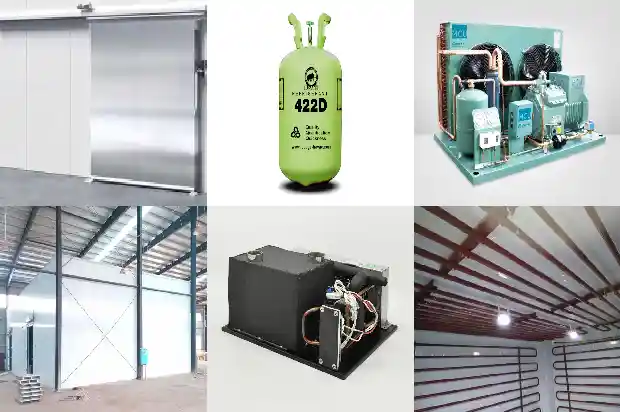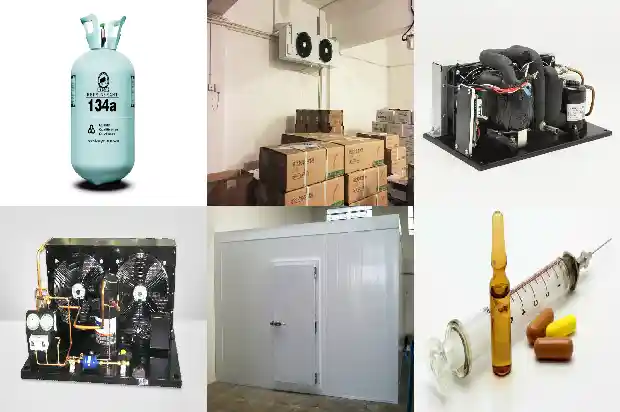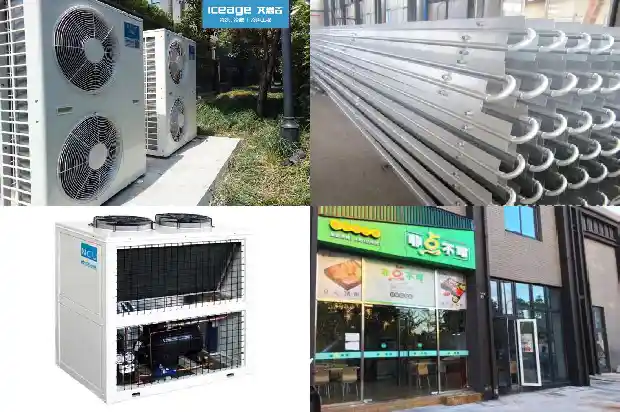Analysis of the Causes and Hazards of Corrosion in the Circulating Water System
2025-02-28
Refrigeration equipment can be divided into two types according to different refrigeration methods: compression refrigeration and absorption refrigeration.

I. Causes of the Formation of Various Scales in the Circulating Water System
Natural water contains various dissolved salts, such as bicarbonates, sulfates, chlorides, silicates, etc. Therefore, if water with a relatively high content of bicarbonates is used as cooling water, it will decompose when it passes through the heat transfer surface of the heat exchanger. The cooling water passing through the cooling tower is equivalent to an aeration process, and the dissolved CO₂ in the water will escape. As a result, the pH value of the water will increase.


Hazards:
① Reduce the heat transfer efficiency of the equipment by 3% - 10%.
② Easily block the steel pipes in the condenser. In mild cases, it will reduce the flow rate and affect the refrigeration effect. In severe cases, the steel pipes in the condenser may even be completely blocked, leading to the scrapping of the equipment.
③ Provide a place for the reproduction of some anaerobic bacteria.
① Reduce the heat transfer efficiency of the equipment by 3% - 10%.
② Easily block the steel pipes in the condenser. In mild cases, it will reduce the flow rate and affect the refrigeration effect. In severe cases, the steel pipes in the condenser may even be completely blocked, leading to the scrapping of the equipment.
③ Provide a place for the reproduction of some anaerobic bacteria.
II. Causes of the Corrosion of Metals in the Circulating Water System
During the normal operation of the cooling water system and the chemical cleaning process, metals often suffer from corrosion in different forms.
According to the knowledge of metal corrosion theory, by carefully observing the metal corrosion morphology of corrosion specimens or damaged equipment, and in combination with some other methods, people can often find out the causes of corrosion and measures to solve the corrosion problem.
According to the knowledge of metal corrosion theory, by carefully observing the metal corrosion morphology of corrosion specimens or damaged equipment, and in combination with some other methods, people can often find out the causes of corrosion and measures to solve the corrosion problem.

- Uniform Corrosion: Uniform corrosion is also known as general corrosion or ordinary corrosion. Its general characteristic is that the corrosion occurs evenly on the entire exposed surface of the metal. During the corrosion process, the metal gradually becomes thinner and is finally damaged.
For carbon steel, uniform corrosion mainly occurs in acidic solutions with a low pH. If too much acid is added and the pH of the cooling water drops to a very low level, obvious uniform corrosion will also occur on carbon steel equipment. - Galvanic Corrosion: Galvanic corrosion is also known as bimetallic corrosion or contact corrosion.
When two different metals are immersed in a conductive aqueous solution, there is usually a potential difference between the two metals. One example of galvanic corrosion in the cooling water system is the galvanic corrosion that occurs between the brass heat exchange tubes and the carbon steel tube sheet or the steel water chamber in the heat exchanger in the cooling water. During the corrosion process, it is the thick steel tube sheet or water chamber that is corroded at an accelerated rate, rather than the thin copper tubes. Since the wall of the steel tube sheet or water chamber is relatively thick, it can still be used for a long time. - Crevice Corrosion: When the metal surface immersed in a corrosive medium is in a crevice or other concealed area, severe local corrosion often occurs.
Hazards:
① Accelerate the corrosion of the equipment, which is likely to cause potential safety hazards.
② Affect normal production and shorten the service life of the equipment.
③ Increase the operation and equipment maintenance costs.
① Accelerate the corrosion of the equipment, which is likely to cause potential safety hazards.
② Affect normal production and shorten the service life of the equipment.
③ Increase the operation and equipment maintenance costs.
III. Causes of the Formation of Slime (Soft Scale)
The microorganisms in the cooling water generally refer to bacteria and algae. In fresh water, there are generally fewer bacteria and algae. However, in the circulation process, due to the concentration of nutrients, the increase in water temperature, and the exposure to sunlight, conditions are created for the rapid reproduction of bacteria and algae. The mucus secreted by a large number of bacteria is like an adhesive, which can make the floating dust impurities and chemical precipitates in the water adhere together, forming a sticky deposit that adheres to the heat transfer surface of the heat exchanger. Some people call this deposit biological slime, and others call it soft scale.
When the slime accumulates on the wall of the heat exchanger tube, in addition to causing corrosion, it will also reduce the flow rate of the cooling water, thereby reducing the cooling efficiency of the heat exchanger. In severe cases, these biological slimes will block the tubes completely, forcing the production to be stopped for cleaning. For example, in a heat exchanger in a certain factory area in Beijing, a large number of bacteria and algae multiplied, and the heat load dropped to 50% within half a month. It was necessary to stop production frequently for flushing, resulting in a decrease in production.
Slime is generally composed of fine particles of sand, dust, insoluble salts in the form of mud, colloidal hydroxides, debris, corrosion products, oil stains, especially the corpses of bacteria and algae and their viscous secretions, etc. Improper water treatment control, too high turbidity of the make - up water, the introduction of fine sand, colloidal substances, etc. into the cooling water system, or untimely killing of bacteria and algae, or serious corrosion with a large amount of corrosion products, as well as careless operation, such as the leakage of oil stains and process products into the cooling water, will all intensify the formation of fouling. When such water quality flows through the surface of the heat exchanger, it is easy to form fouling deposits, especially when the water flows through the shell side, and more fouling deposits are formed in the parts with a slower flow rate. Since this kind of fouling is large in volume and loose and soft in texture, it is also called soft scale. They are the main cause of under - scale corrosion and also a hotbed for the survival and reproduction of some bacteria, such as anaerobic bacteria.
When the slime accumulates on the wall of the heat exchanger tube, in addition to causing corrosion, it will also reduce the flow rate of the cooling water, thereby reducing the cooling efficiency of the heat exchanger. In severe cases, these biological slimes will block the tubes completely, forcing the production to be stopped for cleaning. For example, in a heat exchanger in a certain factory area in Beijing, a large number of bacteria and algae multiplied, and the heat load dropped to 50% within half a month. It was necessary to stop production frequently for flushing, resulting in a decrease in production.
Slime is generally composed of fine particles of sand, dust, insoluble salts in the form of mud, colloidal hydroxides, debris, corrosion products, oil stains, especially the corpses of bacteria and algae and their viscous secretions, etc. Improper water treatment control, too high turbidity of the make - up water, the introduction of fine sand, colloidal substances, etc. into the cooling water system, or untimely killing of bacteria and algae, or serious corrosion with a large amount of corrosion products, as well as careless operation, such as the leakage of oil stains and process products into the cooling water, will all intensify the formation of fouling. When such water quality flows through the surface of the heat exchanger, it is easy to form fouling deposits, especially when the water flows through the shell side, and more fouling deposits are formed in the parts with a slower flow rate. Since this kind of fouling is large in volume and loose and soft in texture, it is also called soft scale. They are the main cause of under - scale corrosion and also a hotbed for the survival and reproduction of some bacteria, such as anaerobic bacteria.
Hazards:
① The slime adheres to the metal surface of the heat transfer (cooling) part, reducing the cooling effect of the cooling water.
② A large amount of slime will block the cooling water channels in the heat exchanger (water cooler), making the cooling water unable to work. A small amount of slime will reduce the cross - sectional area of the cooling water channels, thereby reducing the flow rate of the cooling water and the cooling effect and increasing the pump pressure.
③ The slime accumulates on the surface of the cooling tower packing or between the packing, blocking the passage of the cooling water and reducing the cooling effect of the cooling tower.
④ The slime covers the metal surface inside the heat exchanger, preventing the corrosion inhibitor and scale inhibitor from reaching the metal surface to play their roles in corrosion inhibition and scale prevention, and preventing the biocide from killing the microorganisms in and under the slime, reducing the power.
⑤ The slime covers the metal surface, forming a differential corrosion cell, causing corrosion of these metal equipment.
① The slime adheres to the metal surface of the heat transfer (cooling) part, reducing the cooling effect of the cooling water.
② A large amount of slime will block the cooling water channels in the heat exchanger (water cooler), making the cooling water unable to work. A small amount of slime will reduce the cross - sectional area of the cooling water channels, thereby reducing the flow rate of the cooling water and the cooling effect and increasing the pump pressure.
③ The slime accumulates on the surface of the cooling tower packing or between the packing, blocking the passage of the cooling water and reducing the cooling effect of the cooling tower.
④ The slime covers the metal surface inside the heat exchanger, preventing the corrosion inhibitor and scale inhibitor from reaching the metal surface to play their roles in corrosion inhibition and scale prevention, and preventing the biocide from killing the microorganisms in and under the slime, reducing the power.
⑤ The slime covers the metal surface, forming a differential corrosion cell, causing corrosion of these metal equipment.
Related Articles
- Analysis of Common Auxiliary Components in the Refrigeration System
- Analysis of the Composition, Control and Operation Process of Cold Storage System
- Analysis of Causes for Compressor Liquid Hammer, Overheating and Pre - heating
- Analysis of Seven Reasons for Ice Formation in Computer Room Air Conditioners
- Analysis and Troubleshooting of Common Faults in Air - source Heat Pumps
- Analysis of 6 Components in Air - cooled Multi - split Systems
- Analysis of Advantages, Disadvantages and 34 Common Components of Multi - split Air Conditioners
- Common Causes and Analysis of High and Low Pressure Alarms
- Common Causes and Analysis of Compressor Thermal Protection
- Analysis of Common Faults in Compressor Overcurrent and Burnout
- Analysis of Causes for Safety Valve Leakage
- Analysis of Refrigeration Compressor Motor Faults
- Fault Analysis of Working Principle of Screw Chiller Unit
- Analysis and Treatment of Common Low-Pressure Faults in Chillers
- Analysis and Treatment of Common Low Pressure Faults in Chillers
- Water Cooled Unit Principle of Operation and Parameter Failure Analysis
- Common Fault Causes and Replacement of Multi-connected Unit Compressors
- What Causes the Indoor Unit of an Air - conditioner to Freeze? Here's the Answer~
